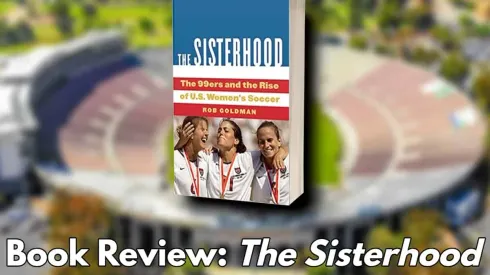In 2021, we are witnessing a change in U.S. women’s soccer. As the national team prepares for the 2023 World Cup, a number of players head to camp to form the next generation of American stars.
The task in front of these young women is tall. They must replace the on-field production of Carli Lloyd or other players nearing the end of their careers. But, it is not just their on-the-pitch production needed.
Equally if not more so, their off-the-field leadership to push for equality and respect in the boardroom of U.S. Soccer and even sports as a whole is key. The outgoing generation worked tirelessly outside of the game for changes in favor of equality. In fact, only the 99ers rival the current core’s progressive actions.
Rob Goldman’s well-timed new book The Sisterhood: The 99ers and the Rise of U.S. Women’s Soccer to coincides with this current generational change.
The Sisterhood
Goldman’s book is an oral history of the rise of women’s soccer in the U.S.
The book starts in 1985 with the creation of a women’s soccer team to play in the Italian Mundialito Cup. It builds on that experience to show how the soccer team grew from that tournament and the ones following.
Using interviews with famous players like Michelle Akers plus quotes from Anson Dorrance and Tony DiCicco, the book builds a narrative to show how U.S. women’s soccer got to 1999. For example, the 1985 Mundialito Cup introduced the team to European-style soccer. Also, it began OOSSAAA chant that became a player tradition.
Their next trip to Italy showed they could compete with European powers, and they used that to build confidence to actually win a tournament in China.
The major takeaway from these narratives and anecdotes in The Sisterhood is that 1999 did not happen in a void. Key players like Mia Hamm, Brandi Chastain, and others were nurtured by older national team players who had learned from their peers. This of course happens to all national teams. Yet, not all national teams see a jump in 25 years from existing to the best team in the world. As the book shows, the 99ers are actually the 85ers-99ers, a composite experience that changed the sport.
Anecdotes and Evidence
The Sisterhood is heavy on interviews, forgoing a list of historical details covered in other books. Goldman tends to focus on the managers and star players as his sources. Therefore, we do not read too many earth-shattering details about the national team between 1985 and 1999. By not talking to as many fringe players or U.S. Soccer sources, the book misses some details or parts of the story that may make it more complete.
However, this book is not a complete telling. Rather, it is a timeline of events building up to the 1999 World Cup. Essentially, Goldman writes to focus readers on the why, not as much the what. This is what makes this book different from others about the early women’s national teams. From the perspectives of those who were most critical in forming it, you hear a narrative about what things, experiences and conflicts got the U.S. to the celebration at the Rose Bowl in 1999.
When reading the description on the book jacket, Goldman and the editors do not claim this is a “definitive” story or a “tell all”. It promises to take you “onto the pitch and into the minds” of key figures in the team. That is what I respected about this book – it does not overpromise, it over-delvers.
In this relatively short read, you walk away with a good understanding of how the U.S. got to where it is in women’s soccer and why that was not a guaranteed outcome. The 1999 experience did not spontaneously happen. This book is not the first to tell how and why, but its laser focus on why through the perspective of the key figures to get it there makes this a good read.
As we celebrate a new generation of savvy U.S. women’s soccer players who will succeed on the pitch and off, The Sisterhood is a good reference point (and a very good read) on how the first generation to achieve such success did it.














